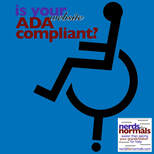Is my website ADA compliant?You might think of the Americans with Disabilities Act, or ADA, as pertaining to buildings and structures but it is also expanding into the digital world. So your website is now also going to come under the scrutiny of the Americans with Disabilities Act. What is the ADA? The purpose of the ADA is to make sure that people with disabilities have the same rights and opportunities as everyone else. It guarantees equal opportunity in public accommodations, employment, transportation, state and local government services and telecommunications. Even if you’re not yet legally obligated to do so, building accessible features and design into your website is good business. Accessibility makes websites easier to use for everyone, not just those with disabilities. This could mean more business for you. And, of course, Google is going to take ADA compliance into account when qualifying your website for search. That’s a given. Part of the problem with older websites is that it used to be a skill set to create sites with embedded technologies and design elements that created a unique experience for desktop computer users. But more and more of the traffic on the Internet is coming from mobile devices. This means that websites that don’t automatically conform to the device that they’re being viewed on also get demoted and even delisted by Google. Sites with features that used to be popular can create barriers for people using assistive devices to browse the Internet. Assistive technologies such as screen readers, text enlargement software and programs that enable people to control the computer with their voice should be able to read your site easliy. Accessible website design recognizes these differences and does not require people to see, hear or use a standard mouse in order to access the information and services provided. What are the guidelines?The most detailed best practices were established by the World Wide Web Consortium (W3) as the Web Content Accessibility Guidelines (WCAG). The WCAG established a set of requirements for digital applications like websites and emails. For each guideline, there are three levels of testable success criteria: A, AA, and AAA. For most RV parks and campgrounds, the goal should be WCAG 2.1 AA.
Six things you can do to get started on making your website more accessible
If you truly want to learn more about building websites that are ADA compliant the U.S. Department of Justice has a document about just that which you can get here. Of course if you want to make sure your website is compliant and adjusts to the ever-changing landscape that’s out there don’t forget I am happy to work with you on a new or revised site. Comments are closed.
|
Tony BarthelTony Barthel is passionate about great marketing for small businesses Get Free Weekly Marketing TipsCategories
All
|
|
Call Tony: (310) 322-3665
|

 RSS Feed
RSS Feed